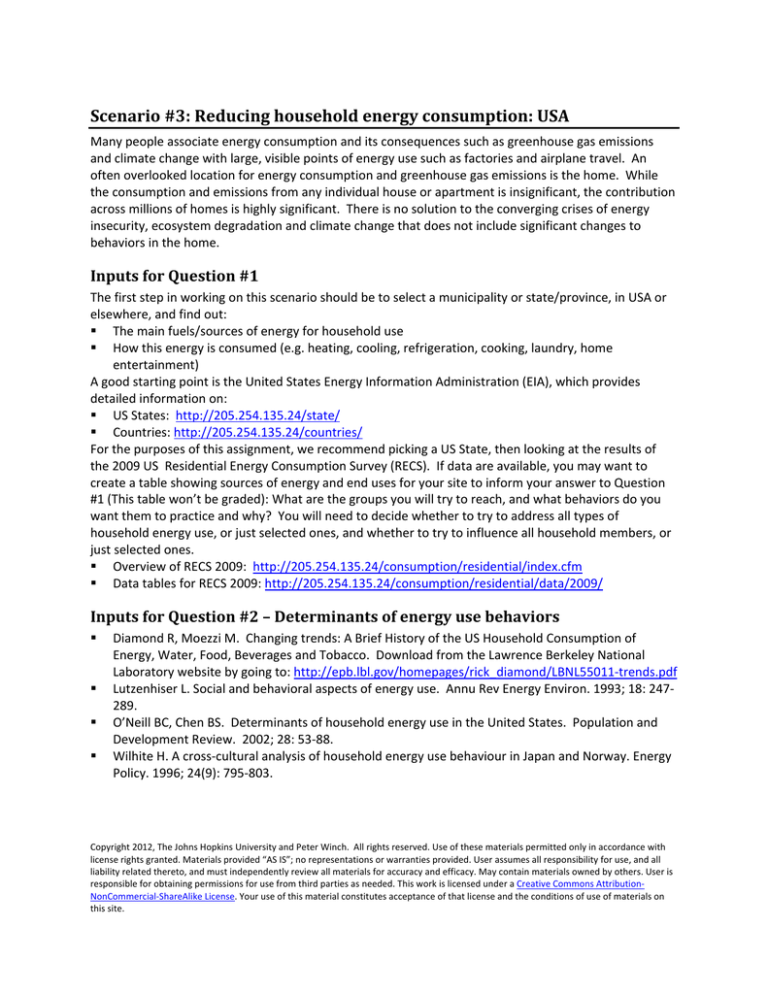
Scenario #3: Reducing household energy consumption: USA Many people associate energy consumption and its consequences such as greenhouse gas emissions and climate change with large, visible points of energy use such as factories and airplane travel. An often overlooked location for energy consumption and greenhouse gas emissions is the home. While the consumption and emissions from any individual house or apartment is insignificant, the contribution across millions of homes is highly significant. There is no solution to the converging crises of energy insecurity, ecosystem degradation and climate change that does not include significant changes to behaviors in the home. Inputs for Question #1 The first step in working on this scenario should be to select a municipality or state/province, in USA or elsewhere, and find out: The main fuels/sources of energy for household use How this energy is consumed (e.g. heating, cooling, refrigeration, cooking, laundry, home entertainment) A good starting point is the United States Energy Information Administration (EIA), which provides detailed information on: US States: http://205.254.135.24/state/ Countries: http://205.254.135.24/countries/ For the purposes of this assignment, we recommend picking a US State, then looking at the results of the 2009 US Residential Energy Consumption Survey (RECS). If data are available, you may want to create a table showing sources of energy and end uses for your site to inform your answer to Question #1 (This table won’t be graded): What are the groups you will try to reach, and what behaviors do you want them to practice and why? You will need to decide whether to try to address all types of household energy use, or just selected ones, and whether to try to influence all household members, or just selected ones. Overview of RECS 2009: http://205.254.135.24/consumption/residential/index.cfm Data tables for RECS 2009: http://205.254.135.24/consumption/residential/data/2009/ Inputs for Question #2 – Determinants of energy use behaviors
Diamond R, Moezzi M. Changing trends: A Brief History of the US Household Consumption of Energy, Water, Food, Beverages and Tobacco. Download from the Lawrence Berkeley National Laboratory website by going to: http://epb.lbl.gov/homepages/rick_diamond/LBNL55011-­‐trends.pdf Lutzenhiser L. Social and behavioral aspects of energy use. Annu Rev Energy Environ. 1993; 18: 247-­‐
289. O’Neill BC, Chen BS. Determinants of household energy use in the United States. Population and Development Review. 2002; 28: 53-­‐88. Wilhite H. A cross-­‐cultural analysis of household energy use behaviour in Japan and Norway. Energy Policy. 1996; 24(9): 795-­‐803. Copyright 2012, The Johns Hopkins University and Peter Winch. All rights reserved. Use of these materials permitted only in accordance with license rights granted. Materials provided “AS IS”; no representations or warranties provided. User assumes all responsibility for use, and all liability related thereto, and must independently review all materials for accuracy and efficacy. May contain materials owned by others. User is responsible for obtaining permissions for use from third parties as needed. This work is licensed under a Creative Commons Attribution-­‐
NonCommercial-­‐ShareAlike License. Your use of this material constitutes acceptance of that license and the conditions of use of materials on this site. Inputs for Question #3 -­ Interventions
Abrahamse W, Steg L, Vlek C, Rothengatter T. A review of intervention studies aimed at household energy conservation. Journal of Environmental Psychology. 2005; 25(3): 273-­‐291. Abrahamse W, Steg L, Vlek C, Rothengatter T. The effect of tailored information, goal setting, and tailored feedback on household energy use, energy-­‐related behaviors, and behavioral antecedents. Journal of Environmental Psychology. 2007; 27(4): 265-­‐276. Brandon G, Lewis A. Reducing household energy consumption: A qualitative and quantitative field study. Journal of Environmental Psychology. 1999; 19: 75-­‐85. Maibach EW, Roser-­‐Renouf C, Leiserowitz A: Communication and marketing as climate change-­‐
intervention assets a public health perspective. Am J Prev Med 2008, 35:488-­‐500. Nisbet MC, Maibach E, Leiserowitz A: Framing peak petroleum as a public health problem: audience research and participatory engagement in the United States. Am J Public Health 2011, 101:1620-­‐
1626. For reference: AJPH special issue on Peak Oil and Health
Barnett DJ, Parker CL, Caine VA, McKee M, Shirley LM, Links JM: Petroleum scarcity and public health: considerations for local health departments. Am J Public Health 2011, 101:1580-­‐1586. Frumkin H, Hess J, Parker CL, Schwartz BS: Peak petroleum: fuel for public health debate. Am J Public Health 2011, 101:1542. Kaza N, Knaap GJ, Knaap I, Lewis R: Peak oil, urban form, and public health: exploring the connections. Am J Public Health 2011, 101:1598-­‐1606. Klare MT, Levy BS, Sidel VW: The public health implications of resource wars. Am J Public Health 2011, 101:1615-­‐1619. Neff RA, Parker CL, Kirschenmann FL, Tinch J, Lawrence RS: Peak oil, food systems, and public health. Am J Public Health 2011, 101:1587-­‐1597. Nisbet MC, Maibach E, Leiserowitz A: Framing peak petroleum as a public health problem: audience research and participatory engagement in the United States. Am J Public Health 2011, 101:1620-­‐
1626. Schwartz BS, Parker CL, Hess J, Frumkin H: Public health and medicine in an age of energy scarcity: the case of petroleum. Am J Public Health 2011, 101:1560-­‐1567. Venkataramani AS, Fried BJ: Effect of worldwide oil price fluctuations on biomass fuel use and child respiratory health: evidence from Guatemala. Am J Public Health 2011, 101:1668-­‐1674. Winch P, Stepnitz R: Peak oil and health in low-­‐ and middle-­‐income countries: impacts and potential responses. Am J Public Health 2011, 101:1607-­‐1614. Copyright 2012, The Johns Hopkins University and Peter Winch. All rights reserved. Use of these materials permitted only in accordance with license rights granted. Materials provided “AS IS”; no representations or warranties provided. User assumes all responsibility for use, and all liability related thereto, and must independently review all materials for accuracy and efficacy. May contain materials owned by others. User is responsible for obtaining permissions for use from third parties as needed. This work is licensed under a Creative Commons Attribution-­‐
NonCommercial-­‐ShareAlike License. Your use of this material constitutes acceptance of that license and the conditions of use of materials on this site.







